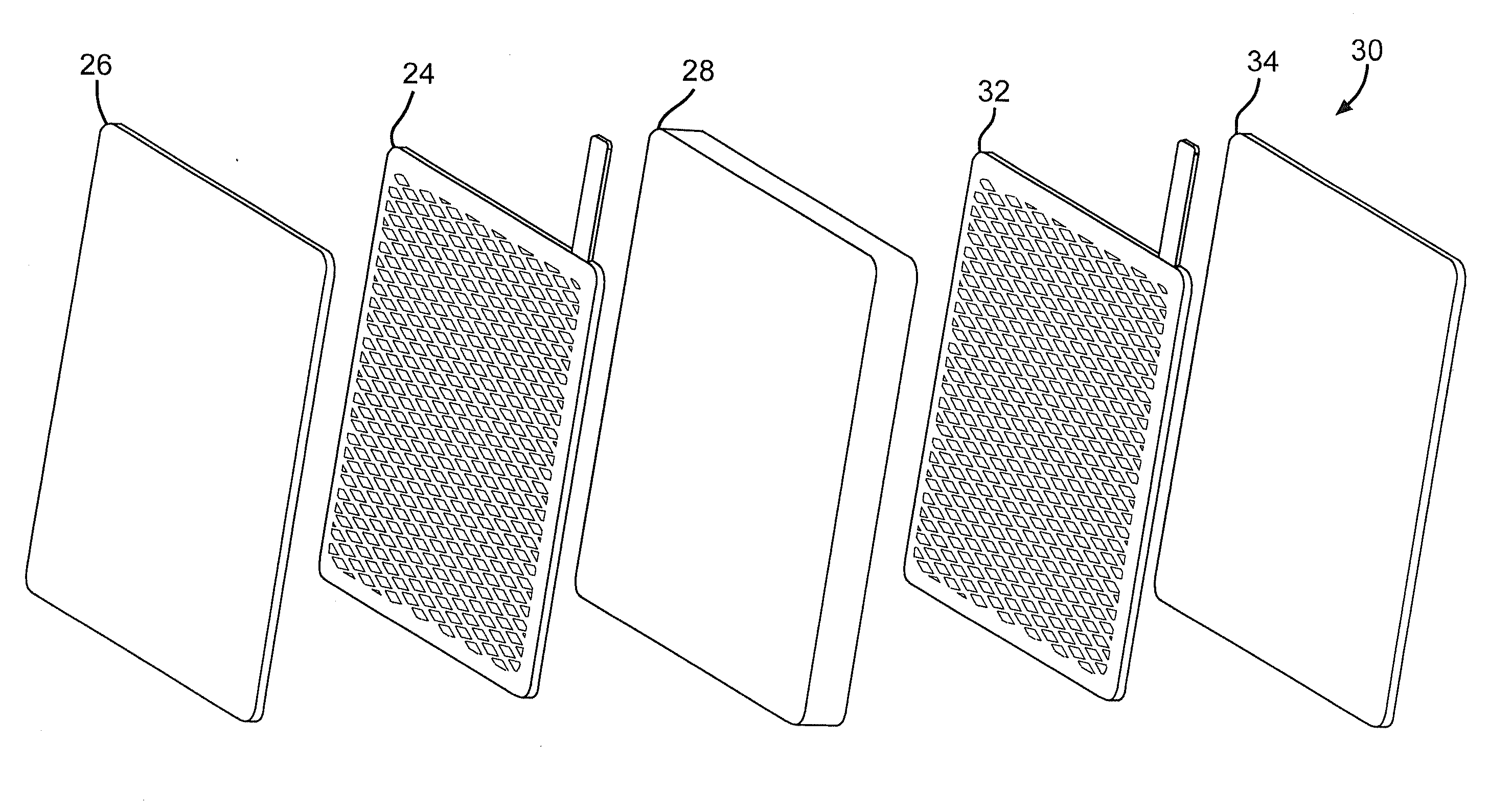Electrochemical Cells And Method Of Manufacturing Same
a technology of electrochemical cells and electrochemical cells, which is applied in the direction of non-aqueous electrolyte cells, cell components, sustainable manufacturing/processing, etc., can solve the problems of exacerbated problems and electrochemical design, and achieve the effects of avoiding damage to the cathode screen due to non-uniform pressing during final assembly, dimensionally more precise and reliable, and improving cell volumetric efficiency
- Summary
- Abstract
- Description
- Claims
- Application Information
AI Technical Summary
Benefits of technology
Problems solved by technology
Method used
Image
Examples
example i
[0074]A group of cathodes and cathode sheets were pressed in the configurations listed in Table 1. For cathodes with non-adhered active material sheets, standard assembly pressures that are used in conventional cathode fabrication were used. Cathode screens were not included in the pressing of non-adhered sheets. Current collectors were of carbon coated titanium screen. The same SVO pressing conditions were used for the SVO sheets of cathodes 1, 2, 1A and 2A. The same CFx pressing conditions were used for the CFx sheets of cathodes 1, 2, 1A, 2A, 1B and 2B. Cathode CFx sheets 3 and 4 were pressed at higher pressure than the sheets of 1, 2, 1A, 2A, 1B and 2B.
[0075]Immediately following pressing, a drop gauge Model ABSOLUTE ID-F12SE manufactured by Mitotoyu was used to measure electrode thickness at the five points A-E indicated in FIG. 4. If cupping of the electrode or electrode sheet was visually observed, the five measurements were made with the cathode and sheet cup facing upward. ...
example ii
[0077]A group of ten cells were made with a cathode comprised of a first sheet of SVO active material, an intermediate carbon coated titanium screen current collector, and a first sheet of CF, active material.
[0078]Five of the ten cells were made according to conventional methods in which the two active materials are pressed and adhered to the current collector. For each of these cells, approximately 1300 milligrams of a CFx material mixture (91% CFx, 4% graphite and 5% PTFE, by weight) was first compressed at low pressure to form a CFx sheet. Approximately 210 milligrams of SVO material mixture (94% SVO, 3% graphite and 3% PTFE, by weight) already made in sheet form was punched in the same shape as the CFx cathode sheet. The SVO sheets and the CFx sheets were then pressed on opposite sides of the titanium current collector screens at high pressure to produce the adhered cathodes having the configuration SVO|CC|CFx.
[0079]The resulting cathodes were then heat sealed into bags formed ...
example iii
[0084]Two groups of five cells were made as described in Example I. Each of the cells were equilibrated at room temperature for five days followed by acceptance pulsing. The cells were then connected to constant resistive discharge loads sized to deplete them of their entire capacity in 90 days. The loads were removed when cell voltage fell below 2 volts.
[0085]Cell voltages were monitored and recorded continuously. FIG. 6 shows the result of this discharge testing. The data plot 94 includes discharge data from both the first five “control” cells and the second five cells of the present invention. It can be seen that the performance of the present cells is again indistinguishable from that of the control cells.
PUM
| Property | Measurement | Unit |
|---|---|---|
| current densities | aaaaa | aaaaa |
| current densities | aaaaa | aaaaa |
| weight percent | aaaaa | aaaaa |
Abstract
Description
Claims
Application Information
 Login to View More
Login to View More - R&D
- Intellectual Property
- Life Sciences
- Materials
- Tech Scout
- Unparalleled Data Quality
- Higher Quality Content
- 60% Fewer Hallucinations
Browse by: Latest US Patents, China's latest patents, Technical Efficacy Thesaurus, Application Domain, Technology Topic, Popular Technical Reports.
© 2025 PatSnap. All rights reserved.Legal|Privacy policy|Modern Slavery Act Transparency Statement|Sitemap|About US| Contact US: help@patsnap.com



